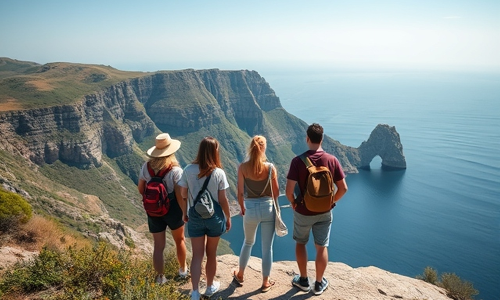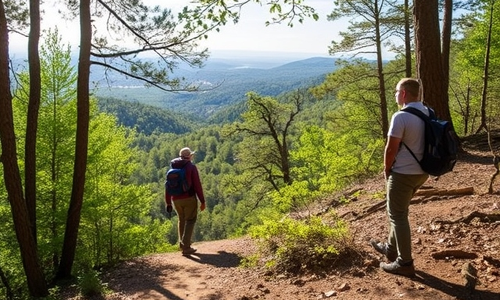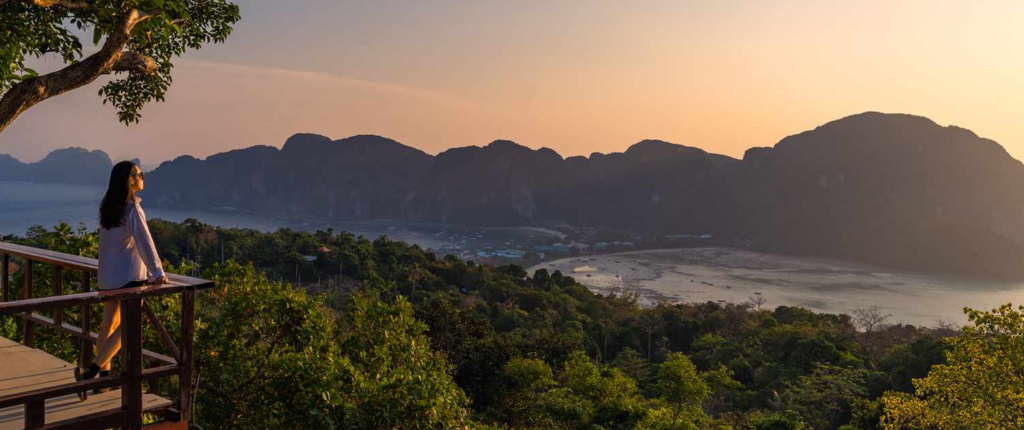Traveling can be one of the most rewarding ways to explore the world, gain new perspectives, and create lasting memories. However, it can also leave a significant impact on the environment-through carbon emissions, excessive waste, and strain on local resources. Adopting eco-friendly practices doesn’t necessarily require a big budget or sacrificing comfort. By making mindful choices, travelers can minimize their environmental footprint while still experiencing the joys of exploration. This guide offers practical travel tips for planning and enjoying a sustainable trip, even on a tight budget.
1. Planning Eco-Conscious and Budget-Friendly Trips
 Choose Closer Destinations
Choose Closer Destinations
- Less Distance, Lower Emissions: Selecting destinations nearer to your home reduces the need for long flights or extensive road trips, cutting down on carbon emissions.
- Hidden Gems: Local or regional travel often leads to discovering offbeat spots you might otherwise overlook, supporting smaller communities and more authentic cultural experiences.
Opt for the Right Season
- Avoid Overtourism: Traveling during the shoulder or off-seasons can help reduce the stress on local resources and is typically more affordable. You’ll also encounter fewer crowds while enjoying discounted accommodation and activities.
- Eco-Friendly Timing: In places with vulnerable ecosystems, certain seasons are more beneficial for minimal impact—like avoiding breeding seasons for wildlife to reduce disturbances.
Research Eco-Certified Accommodations
- Look for Green Credentials: Websites like Green Key, Eco Hotels, or local sustainable tourism certifications can help you identify environmentally responsible options.
- Budget Stays: Eco-friendly accommodations aren’t always expensive. Many hostels, guesthouses, and homestays follow green practices such as solar power, waste reduction, and community-based tourism initiatives.
2. Getting There: Greener Modes of Transport
 Opt for Public Transportation
Opt for Public Transportation
- Buses and Trains: Using shared transport like buses or trains significantly lowers your carbon footprint compared to driving alone. Plus, public transport is usually cheaper than private modes.
- Slow Travel: Embrace the journey. Overnight trains or buses can save you a night’s accommodation cost, letting you wake up in a new location.
Carpooling and Rideshares
- Share the Ride: If a car is necessary, split costs and emissions with fellow travelers or friends via rideshare apps or community boards.
- Efficient Driving: When driving, maintain optimal tire pressure, avoid rapid acceleration, and plan routes to minimize mileage—small steps that save fuel and money.
Choose Flights Wisely
- Limit Air Travel: Flying is one of the largest contributors to travel-related carbon emissions. Consider flying only when necessary or choosing direct routes to reduce takeoffs and landings.
- Carbon Offset Programs: If you must fly, some airlines and third-party organizations offer offset programs where you can invest in reforestation or clean energy projects to balance out your flight’s emissions.
3. Sustainable Accommodations on a Budget
 Hostels, Guesthouses, and Homestays
Hostels, Guesthouses, and Homestays
- Community-Centric: These smaller accommodations often rely on local labor, local produce, and maintain simpler energy requirements—leading to a smaller carbon footprint.
- Shared Facilities: Hostel dorm rooms encourage shared resources (heating, lighting), cutting energy use and costs. Many also provide communal kitchens, allowing you to cook with local ingredients.
Eco-Lodges and Campgrounds
- Closer to Nature: Eco-lodges and campgrounds are designed to operate in harmony with their surroundings. Some use renewable energy or composting toilets, further reducing environmental impact.
- Budget-Friendly Alternatives: While some eco-lodges can be premium, many run by nonprofits or local communities remain budget-friendly, ensuring authentic experiences without high costs.
Look for Sustainability Indicators
- Water and Energy Conservation: Check if accommodations have implemented measures like low-flow toilets, solar panels, or energy-efficient lighting.
- Waste Management: Properties that encourage waste segregation, composting, or minimal single-use plastics usually prioritize sustainability.
4. Low-Waste and Eco-Friendly Practices During Your Stay
 Pack Your Reusables
Pack Your Reusables
- Water Bottle: Avoid buying single-use plastics by carrying a reusable water bottle. In regions where tap water may be unsafe, use water purification tablets or a filter.
- Travel Cutlery and Containers: Having your own metal straw, spork, or a small container can significantly reduce reliance on disposable items.
- Reusable Tote Bag: A foldable tote is invaluable for groceries or souvenirs without resorting to plastic bags.
Support Local, Seasonal, and Vegetarian-Friendly Food
- Dine Locally: Eating at family-run restaurants or street-food stalls keeps money in the community and exposes you to authentic regional cuisine.
- Opt for Veg or Vegan Meals: Reducing meat consumption lowers your carbon footprint. Even a few vegetarian meals per trip can contribute to more sustainable travel.
Conserve Water and Electricity
- Shorter Showers: Freshwater is a valuable resource, especially in many developing regions. Keep showers brief and turn off taps when not in use.
- Lights and Electronics Off: When leaving your room, ensure all lights and electronic devices are turned off to minimize energy usage.
5. Connecting with Local Culture and Nature Responsibly
 Guided Nature Tours and Hikes
Guided Nature Tours and Hikes
- Community-Based Tourism: Look for tours led by local guides, as they often know how to reduce environmental impact while maximizing cultural understanding.
- Stay on Marked Trails: Venturing off-trail can damage fragile ecosystems, so follow guidelines to preserve habitats.
Ethical Wildlife Encounters
- Avoid Exploitative Activities: Research whether activities like elephant rides, tiger shows, or captive animal experiences treat wildlife humanely. Choose reputable sanctuaries and conservation centers instead.
- Maintain Distance: Observing wildlife from a safe distance ensures both your safety and the animal’s well-being.
Volunteerism and Community Projects
- Give Back: For travelers seeking a deeper connection, consider volunteering in community development or conservation projects.
- Ethical Volunteering: Ensure the organization is reputable, transparent about its funding, and beneficial to the local community.
6. Digital Nomadism and Remote Work: Balancing Eco-Friendly Travel
 Longer Stays in Fewer Locations
Longer Stays in Fewer Locations
- Slow Travel Benefits: By staying longer in one place, you reduce your overall carbon footprint from constant transport, and you can develop closer ties to the community.
- Local Co-Working Spaces: Many destinations now offer co-working facilities, letting you balance work with immersion in local culture without high travel frequency.
Energy-Efficient Tech Practices
- Minimal Printing: Use digital apps for boarding passes, maps, and itineraries.
- Device Management: Switch off laptops and other gadgets when not in use, especially overnight, to conserve power.
7. Budget-Friendly Sustainable Shopping and Souvenirs
 Buy Local Handicrafts
Buy Local Handicrafts
- Support Artisans: Purchasing directly from local craftspeople supports their livelihoods while reducing the carbon footprint associated with mass-produced goods.
- Eco-Friendly Materials: Look for souvenirs made from natural or recycled materials, such as bamboo, jute, or reclaimed wood.
Consumable Gifts
- Spices, Teas, and Oils: Food-based items typically have less packaging waste and reflect a region’s culinary identity.
- Locally Made Cosmetics: Homemade soaps, essential oils, or herbal lotions offer a zero-waste alternative to plastic-packed products.
8. Budget Tips for Sustainable Travel
- Choose Off-Peak Seasons: Costs for hotels and flights tend to be lower, reducing both overtourism and your travel expenses.
- Stay in One Region: Slow travel cuts down on transport costs and environmental impact. You can delve deeper into local culture, saving on repeated flight or train expenses.
- Cook Your Own Meals: If staying in a hostel or homestay with a kitchen, buy local produce and cook simple meals to control food waste and costs.
- Prioritize Free or Low-Cost Activities: Nature walks, local festivals, and community events often cost less and provide authentic cultural immersion.
- Use Public Libraries and Apps: Borrow guidebooks or download digital maps instead of buying new ones for each trip.

Conclusion
Madhya Pradesh’s offbeat destinations offer a deeper look into the state’s cultural tapestry, natural wonders, and hidden histories. From the pristine hill station of Tamia to the ancient weaving traditions of Chanderi and the untouched wilderness of places like Nauradehi and Bori, these hidden gems promise enriching experiences far from typical tourist circuits. If you’re keen on exploring authentic tribal culture, witnessing magnificent wildlife without the crowds, or immersing yourself in centuries-old crafts and architecture, Madhya Pradesh’s lesser-known spots await you with open arms.
So, the next time you plan a trip to Madhya Pradesh, consider stepping off the beaten path. You’ll not only discover uncharted wonders and hidden communities but also leave with memories of a side of India that remains refreshingly original and captivating.
WELCOME TO KANHA NATIONAL PARK

